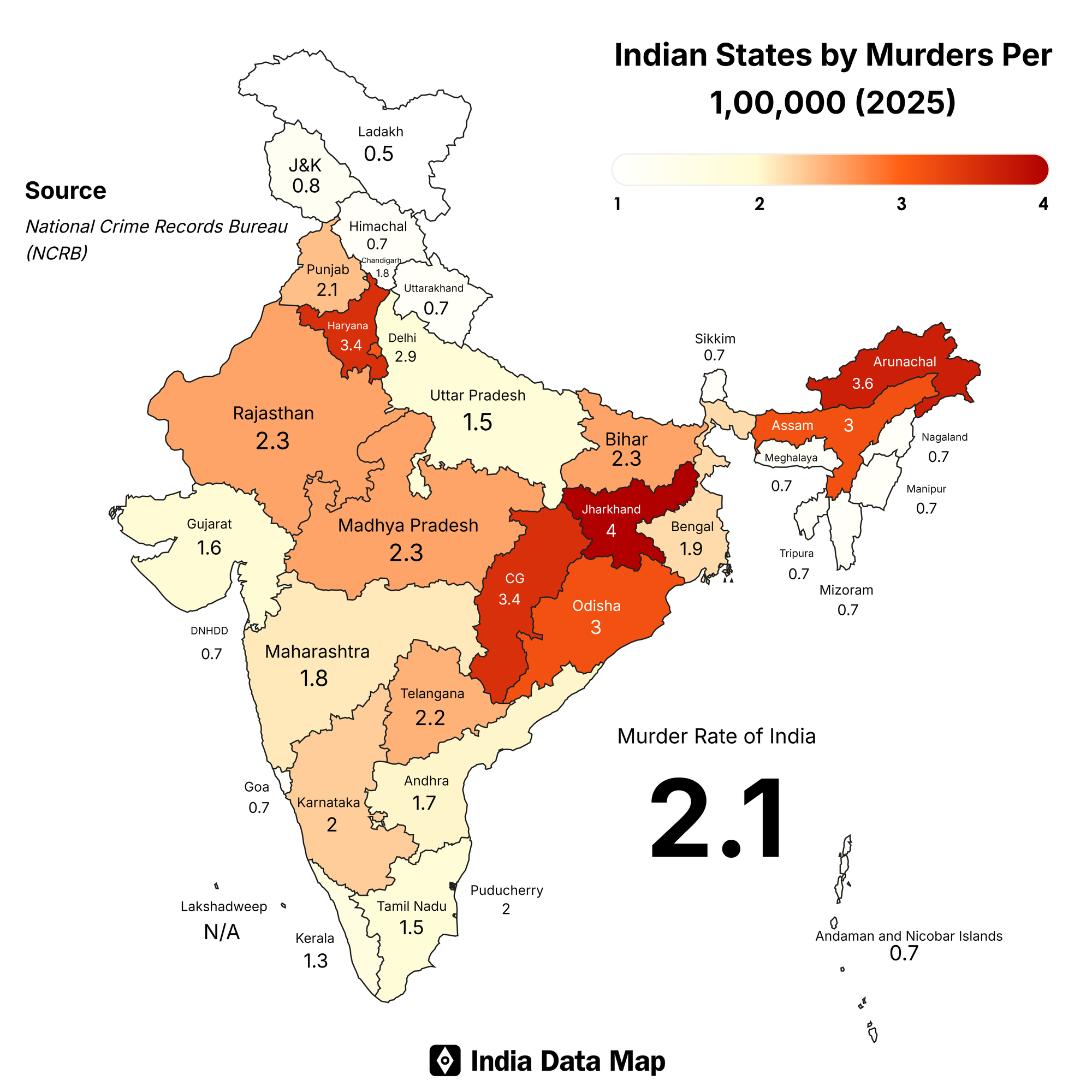India, characterized by its diverse states and union territories, showcases a varied landscape regarding crime statistics.
The murder rate, an essential measure of public safety, exhibits considerable variation across the nation's 28 states and 8 union territories (UTs).
Drawing on 2025 data from the National Crime Records Bureau (NCRB), this article explores the murder rates throughout India, emphasizing key facts and fascinating insights that illuminate regional disparities in violent crime.

| Rank | State/Union Territory | Murder Rate (per 100,000 people) |
|---|---|---|
| 1 | Jharkhand | 4.0 |
| 2 | Arunachal Pradesh | 3.6 |
| 3 | Chhattisgarh | 3.4 |
| 4 | Haryana | 3.4 |
| 5 | Assam | 3.0 |
| 6 | Odisha | 3.0 |
| 7 | Delhi | 2.9 |
| 8 | Bihar | 2.3 |
| 9 | Madhya Pradesh | 2.3 |
| 10 | Rajasthan | 2.3 |
| 11 | Telangana | 2.2 |
| 12 | Punjab | 2.1 |
| 13 | Puducherry | 2.0 |
| 14 | Karnataka | 2.0 |
| 15 | West Bengal | 1.9 |
| 16 | Maharashtra | 1.8 |
| 17 | Chandigarh | 1.8 |
| 18 | Andhra Pradesh | 1.7 |
| 19 | Gujarat | 1.6 |
| 20 | DNHDD | 1.6 |
| 21 | Tamil Nadu | 1.5 |
| 22 | Uttar Pradesh | 1.5 |
| 23 | Kerala | 1.3 |
| 24 | Jammu and Kashmir | 0.8 |
| 25 | Andaman and Nicobar Islands | 0.7 |
| 26 | Ladakh | 0.5 |
| 27 | Lakshadweep | N/A |
| 28 | Goa | N/A |
| 29 | Himachal Pradesh | 0.7 |
| 30 | Manipur | 0.7 |
| 31 | Meghalaya | 0.7 |
| 32 | Mizoram | 0.7 |
| 33 | Nagaland | 0.7 |
| 34 | Sikkim | 0.7 |
| 35 | Tripura | 0.7 |
| 36 | Uttarakhand | 0.7 |
Key Insights from 2022 Homicide Statistics and 2025 Projections
In 2022, India documented 28,522 homicide incidents, resulting in a national homicide rate of 2.1 per 100,000 individuals.
Jharkhand had the highest murder rate among states at 4.0 per 100,000, closely followed by Arunachal Pradesh (3.6), Chhattisgarh (3.4), and Haryana (3.4). Among Union Territories, Delhi had the highest rate at 2.9, highlighting the challenges of urban crime.
Conversely, Lakshadweep reported no murders, a remarkable statistic considering India’s population exceeds 1.4 billion.
States such as Goa, Himachal Pradesh, Manipur, Meghalaya, Mizoram, Nagaland, Sikkim, Tripura, and Uttarakhand exhibited particularly low murder rates at 0.7, consistent with smaller Union Territories like the Andaman and Nicobar Islands (0.7) and Ladakh (0.5).
By 2025, the overall crime rate in India experienced a slight decline to 422.2 incidents per 100,000 individuals, marking a 0.56% reduction from 2024, which indicates a potential improvement in law enforcement or reporting practices.
However, the specific murder rates for 2025 by state are not comprehensively detailed in the available data, necessitating reliance on the 2022 statistics for accuracy, while acknowledging that trends may have changed slightly.
Uttar Pradesh, with 3,491 murder cases in 2022, represented a considerable portion of the total incidents, although its rate of 1.5 per 100,000 was below the national average, likely attributable to its large population.
Interesting Observations
Regional Variations: Jharkhand’s high murder rate may stem from socio-economic challenges or regional conflicts, while states like Kerala (1.3) and Tamil Nadu (1.5) maintain lower rates, possibly due to robust policing or social cohesion.
The Northeast, including states like Mizoram and Nagaland (both 0.7), appears safer, though this may reflect under-reporting in these complex regions.
Lakshadweep’s Exception: Lakshadweep’s zero murder rate is remarkable, likely tied to its small, isolated population of about 64,000. This contrasts sharply with high-rate states like Jharkhand, highlighting how geography and community size influence crime.
Urban Crime Pressures: Delhi’s 2.9 murder rate underscores urban challenges, with 509 murder cases in 2022. This aligns with broader 2025 trends showing higher crime rates in urban areas like Delhi, where population density and economic disparities fuel violence.
Conversely, rural states like Uttar Pradesh and Maharashtra (1.8) report lower per-capita rates, possibly due to effective policing or data gaps.
Motives Behind Murders: In 2022, disputes (9,962 cases), personal vendettas (3,761), and gain (1,884) were the leading motives for murders, suggesting that interpersonal and economic tensions drive much of India’s violent crime.
This pattern likely persists into 2025, given the marginal drop in overall crime.
Conclusion
The murder rates in India for the year 2022, along with minor improvements observed in the crime trends of 2025, illustrate a complicated interaction of regional, urban, and socio-economic elements.
Jharkhand and Delhi face high murder rates, whereas Lakshadweep and northeastern states such as Mizoram and Nagaland are considered safer areas.
The slight reduction in overall crime by 2025 indicates some progress; however, the persistent high murder rates in specific regions necessitate focused interventions.
As India continues its urbanization process, it will be crucial to tackle the underlying causes of violence—such as disputes, vendettas, and economic pressures—to improve safety throughout this diverse country.









